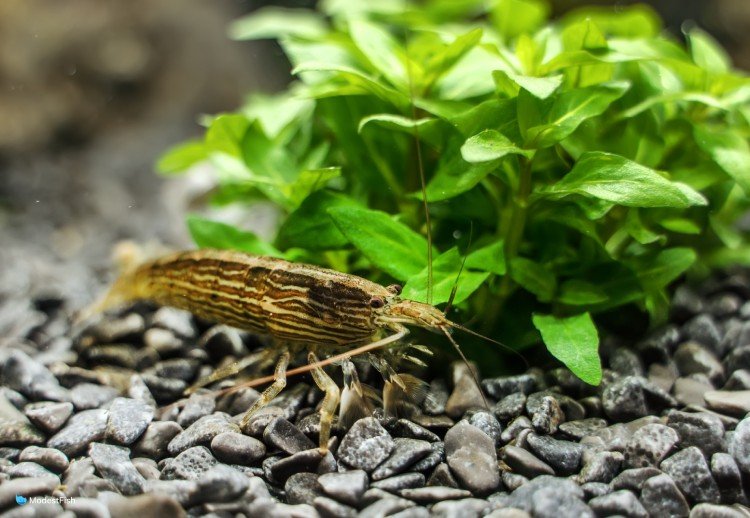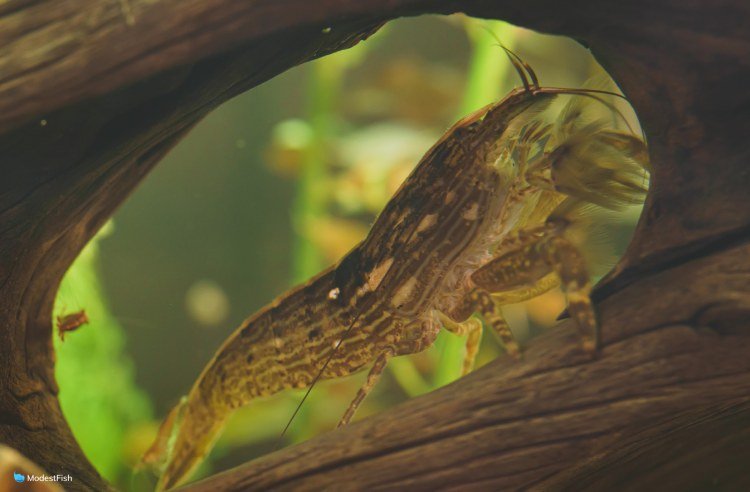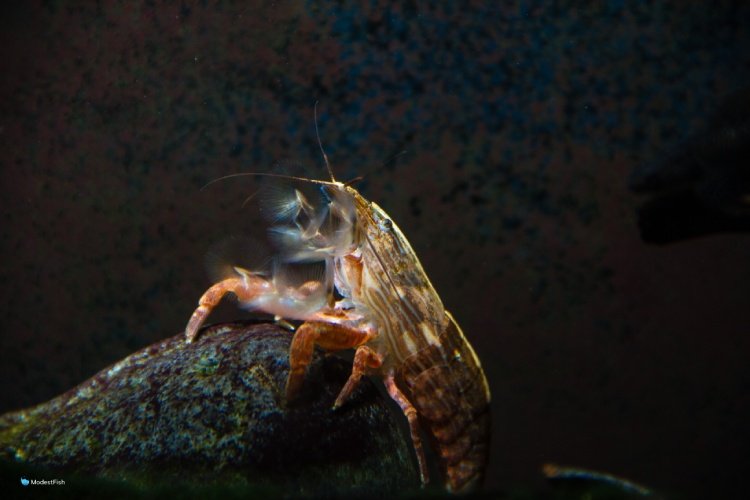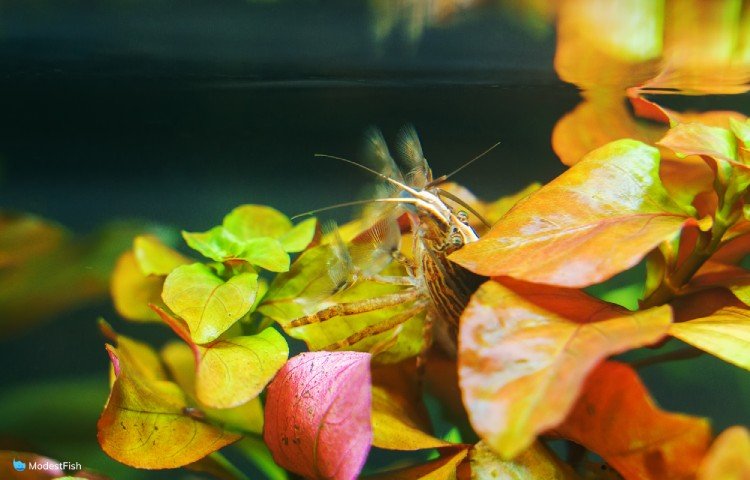[ad_1]
Bamboo shrimp (Atyopsis moluccensis) are delightful little odd-balls you absolutely must add to you’re tank, if you have the skill level.
See, these critters can be very demanding.
In this guide, I’ll explain their care requirements and the potential pitfalls. But, no worries, if bamboo shrimp aren’t right for you, I’ll share with you some shrimp which’ll bring you just as much joy and are more forgiving.
Quick Stats
- Care Level: difficult
- Min. Tank Size: 20 gallon (76 liter)
- pH: 7.0-8.0
- Temperature: 68°-77°F (20°-25°C)
- Diet: detritivore/filter feeder
- Temperament: peaceful
- Lifespan: 1-2 years
- Size: 3 inches (7.5 centimeters)
- Family: Atyidae
- How many can be kept together: group of five or more
- Scientific Name: Atyopsis moluccensis
- Common Name: bamboo shrimp, wood shrimp, fan shrimp, flower shrimp
Bamboo Shrimp Species Profile

At a glance, bamboo shrimp seem very similar to other large freshwater shrimp species. But, look a little deeper, and you’ll see that they are quite unique among the species that are available in the hobby.
They are fairly large for a freshwater shrimp, with some adults reaching as much as 3 inches in length.
They have a light beige, almost white stripe on the top of their bodies that runs from nose to tail.
The sides of their bodies have a pattern of beige and white stripes that look very similar to wood grain, hence one of their many common names “wood shrimp.”
So, at first glance, these shrimp just look like kinda big ornamental shrimp that have a cool pattern on their sides. But then, they start to feed!
Bamboo shrimp have evolved to be filter feeders. Most freshwater shrimp have tiny claws on their front legs that they use to scrape up food and place it in their mouths, but not these guys.
A bamboo shrimp’s first four legs end in specialized feeding appendages, made of hairs that they open like round fans.
They hold these fans open in areas of high water flow, and as tiny bits of food float through the fans, they get stuck to the hairs.
Then the shrimp can then scrape it into their mouths.
I must say, the fans are really cool looking and kind of hypnotic.
The shrimp face into a current and open up their fans, like a little cluster of flowers, and every few seconds, they gracefully fold one to feed off it and then open it again.
I find them very peaceful to watch.
In the Wild
These shrimp are native to fast running waterways all over Southeast Asia: Thailand, Cambodia, Sri Lanka, Malaysia, Indonesia.
They tend to congregate in areas of high flow and water turbulence. The current in these areas kicks up detritus into the water column, where the shrimp can then filter it out.
Bamboo shrimp will feed on floating bits of algae, fish poop, bits of plant material, tiny crustaceans, basically, any little organic particle that floats by.
In the Aquarium

Much like they do in the wild, bamboo shrimp will usually congregate in areas with the strongest water flow. Once they find a spot they like, they’ll open their fans and start to feed.
These little guys are very peaceful. They are completely non-aggressive and compatible with small community fish.
Bamboo shrimp can be difficult to keep in the aquarium. I do not recommend this species for beginners.
You have to strike a delicate balance between making sure there is enough food available in the water column, but also making sure not to overfeed.
If there’s not enough food floating in the water, the shrimp will try to get food from the substrate, but this is really inefficient for them. So, they’ll eventually starve to death.
But, if there’s too much food floating around the tank, it will start to break down and foul your water.
And this species is particularly sensitive to water quality. Sudden ammonia spikes can easily kill them.
It takes some finesse and dedication to keep this species.
I think they’re really rewarding and worth the effort, but it’s important to know what you’re getting yourself into.
Bamboo shrimp need to be housed in a well established aquarium. If you’ve only recently set up your tank, wait at least several months before you add these shrimp. They need mulm and other organic material to feed on. They can starve in new setups that are too clean.
How to Set Up a Bamboo Shrimp Tank

Tank Size
It’s best to keep this species in at least a 20 gallon (76 liter), but bigger is always better.
Filtration
You have to strike a somewhat delicate balance when it comes to keeping bamboo shrimp.
On the one hand, they are fairly delicate when it comes to water parameters, so they need a filter that will prevent ammonia spikes and keep the tank balanced.
On the other hand, though, you need a filter that won’t remove all the detritus in the water.
I’d recommend using a sponge filter with this species. Bamboo shrimp like to sit on sponge filters and take advantage of the flow they create. They’ll also scrape detritus and gunk off the surface of the sponge.
To see more detailed information about sponge filters, check out our in-depth article, here.
Powerheads
I highly recommend adding on a powerhead, or two, depending on the size of your tank.
Powerheads are a great way to add on extra waterflow. They’ll help keep detritus suspended in the water so the bamboo shrimp can eat it.
For our in-depth article comparing powerheads, please, click here.
Water Parameters
- Temperature: 68°-77°F (20°-25°C)
- Ammonia/Nitrite: 0
- Nitrate: <20 ppm
- pH: 7.0-8.0
- GH: 4-18 dGH
- KH: 3-8 dKH
Heater
This species does not require a heater. They can thrive in a heated tank or an unheated one.
You’ve gotta love a species with this kind of flexibility.
Substrate
Bamboo shrimp don’t really have any particular needs when it comes to substrate.
Gravel, sand, clay substrate, any of these will work.
I would just caution that some aquarium soils can leach ammonia and/or reduce the pH of the water, especially when the tank is first set up.
Make sure that your parameters are stable and within the right range before you add bamboo shrimp to the tank.
Lighting
This species doesn’t really have needs when it comes to lighting. Just use whatever lights you want for your live plants, or even just your viewing pleasure.
The shrimpy people really won’t care.
Plants and Decor

Bamboo shrimp really appreciate a lot of hardscape elements in a tank. Rocks and driftwood give the shrimp multiple options for feeding perches.
They can also walk along the hardscape and scrape up algae and biofilm growing on the surfaces.
These guys also need lots of hiding areas to choose from. All shrimp molt their exoskeletons as they grow. When they do so, their new exoskeleton is very soft for a few days, making them much more vulnerable to predation.
So, they usually hide themselves away until their new shell hardens up. They’ll tuck themselves into a little nook for a few days and then emerge once they feel safe again.
This species does benefit from having live plants in the tank. Little bits of plant material in the water are like a tasty salad for bamboo shrimp.
Plus, live plants are a great habitat for little crustaceans and other tiny critters that these shrimp can feed on.
Tank Lid
I highly recommend using a tight fitting lid if you plan on keeping bamboo shrimp.
They have been known to climb out of tanks, especially if they aren’t getting enough food.
Freshwater shrimp can survive for a short period of time out of the water, but will soon die once their oxygen becomes depleted.
Bamboo Shrimp Diet
This species is truly omnivorous. They’ll eat just about anything as long as it’s ground up fine enough.
Powdered foods are best:
- Spirulina powder – rich in protein and vitamins
- Ground flake food – the same food you would feed your fish. You can grind it up with a mortar and pestle, or even just with your fingers.
- Fry food – these powdered foods are another great source of protein. There are also specialized formulas meant for baby shrimp that are very nutritious.
Powdered foods can be mixed with a little bit of water and then squirted into the water close to the shrimp with a pipette or dropper.
If you see your bamboo shrimp raking the bottom of the aquarium, they are not getting enough to eat from the water column. Consider adding some food close to the shrimp, so they can easily find it, and/or some more water flow to keep detritus suspended in the water.
Bamboo Shrimp Breeding
Happy and healthy bamboo shrimp will breed in an aquarium environment.
The problem is trying to raise the babies.
Some freshwater shrimp hatch out of their eggs as a perfect replica of their parents.
But bamboo shrimp, like Amano shrimp, are different. When their eggs hatch, free swimming larvae emerge. In the wild, these larvae would be swept away with the current into brackish water at the mouth of the river.
The larvae cannot survive without the high salt content of the brackish water.
As they mature, and develop into shrimplets, they will migrate up the river until they get back to freshwater.
These conditions are next to impossible to recreate in an aquarium environment.
This is why all of the bamboo shrimp that you see in stores are wild caught. Breeding them just isn’t practical.
Bamboo Shrimp Tank Mates
These little guys are pretty much defenseless. Any tank mates need to be extremely peaceful.
Cherry shrimp would be a great choice. Both species will thrive in similar conditions and cherries will help eat up food that the bamboo shrimp miss.
Small, peaceful schooling fish, like chili rasboras or guppies, are good choices, but you’ll need to add a heater to the tank.
Snails are another good fit, like nerite or mystery snails. Snails will help clean up any food the shrimp miss.
Make sure to avoid anything that could be considered aggressive or semi-aggressive, like tiger barbs or most cichlids.
And definitely, do not put the bamboo shrimp in with a fish big enough to easily swallow them.
Even “peaceful” fish that are big enough won’t hesitate to gulp down any shrimp they come across.
Are Bamboo Shrimp Right for You?
This awesome oddball is a really cool species to keep in your tank. They can be kinda demanding, which is why I rate them as being difficult to keep.
They need a very stable tank that’s mature enough to have lots of organics in the water column for them to feed on.
As an aquarist, you’ve got to strike a balance between keeping the shrimp fed, but not overfed, on a daily basis.
This level of care isn’t for everyone. I don’t want to discourage anyone, but I also want to make sure people know that this is sort of a high maintenance species.
If you’re looking for really simple shrimp to add to your tank, I would recommend cherry shrimp. They can survive just about anything.
Seriously, you could practically raise them in a toilet.
I hope you find this article helpful.
I wish you and your fish the very best!
[ad_2]
Source by [author_name]



